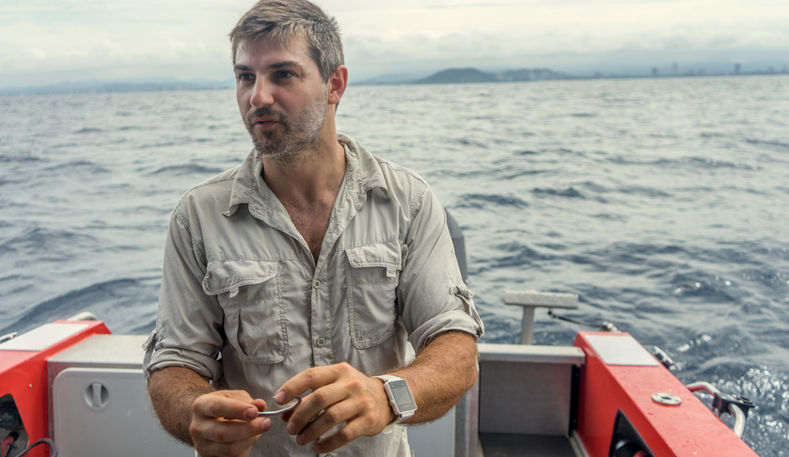Media
All Videos
All Videos


Back from the Brink - Season 1 Episode 2 - Scalloped Hammerhead Shark

SHARK STUDY on 9 news

A day with a shark scientist
Photographs of our Hammerhead shark projects.
Credit to Matthieu Glemarec
Science Outreach

Johan and Mariel preparing for Splendor in the Grass Science Tent 2018

Dr Familiar Lopez

A hammerhead shark specimen which we used in a news report about our research. Media communication is an important aspect for science communication

Johan and Mariel preparing for Splendor in the Grass Science Tent 2018
Other media links
-
National Geographic Wild Series - When Sharks Attack
-
2018 - Episode 4: Terror down under
-
2019 - Just completed filming for release in 2019.
-
https://www.nationalgeographic.com.au/tv/when-sharks-attack/
-
-
Discovery Channel - Strange Evidence, Season 2
-
Bull sharks in Fresh water lakes
-
-
ABC National News, Channel 9news, Channel 7news.
-
Various presentations, public seminars and community engagements.
Publications
-
Johan Gustafson (2020) Hammerhead sharks (Sphyrnidae) of southeast Queensland: habitat and movements. PhD thesis.
Hammerhead sharks (Sphyrnidae) are an iconic species receiving little attention in Australian waters. This thesis aimed to investigate the scalloped hammerhead (Sphyrna lewini) in Queensland, Australia. Multiple methodologies were used to determine (i) the distribution of suitable habitat for juvenile sharks and overlap with marine protected areas; (ii) fine-scale movement of juvenile sharks within these habitats and behavioural state-switching; (iii) thermal tolerance range of hammerhead sharks using historical catch records from the QSCP; and (iv) isotopic ecology between hammerhead sharks and co-existing large sharks. Species distribution modelling identified high suitable habitat in developed areas, occurring in low protection zones and outside of MPAs. Two diving patterns were observed, and two-state behavioural modelling uncovered activity states were influenced by distance to seagrass, coral, and depth. Quantile regression determined catches of hammerhead sharks related to sea surface temperature, catches in southern areas likely to occur between 20℃ - 25℃ and throughout the year in northern areas. Stable isotope analysis suggested scalloped and great hammerheads overlapped 69% in isotopic space and with other large sharks. Scalloped hammerheads were less specialised great hammerheads. In summary, this thesis provides new information and highlight the relevance of movement and habitat use information in the conservation and management of endangered shark species.
-
Queiroz, N., Humphries, N. E., Couto, A., Vedor, M., Da Costa, I., Sequeira, A. M., ... , Gustafson, J, et al (2019). Global spatial risk assessment of sharks under the footprint of fisheries. NATURE. 572(7770): 461-466.
Effective ocean management and the conservation of highly migratory species depend on resolving the overlap between animal movements and distributions, and fishing effort. However, this information is lacking at a global scale. Here we show, using a big-data approach that combines satellite-tracked movements of pelagic sharks and global fishing fleets, that 24% of the mean monthly space used by sharks falls under the footprint of pelagic longline fisheries. Space-use hotspots of commercially valuable sharks and of internationally protected species had the highest overlap with longlines (up to 76% and 64%, respectively), and were also associated with significant increases in fishing effort. We conclude that pelagic sharks have limited spatial refuge from current levels of fishing effort in marine areas beyond national jurisdictions (the high seas). Our results demonstrate an urgent need for conservation and management measures at high-seas hotspots of shark space use, and highlight the potential of simultaneous satellite surveillance of megafauna and fishers as a tool for near-real-time, dynamic management.
-
Mochamad Furqon Azis Ismail, Joachim Ribbe, Johannes Karstensen, Charles Lemckert, Serena Lee, Johann Gustafson. (2017). The Fraser Gyre: A cyclonic eddy off the coast of eastern Australia.
This paper examines the on-shelf circulation of the eastern Australian continental shelf for a region off southeast Queensland. We identify a characteristic seasonally reoccurring wind-driven cyclonic flow. It influences the cross-shelf exchange with the East Australian Current (EAC), which is the western boundary current of the South Pacific Ocean. We refer to this cyclonic circulation as the Fraser Gyre. It is located south of Fraser Island between about 25 °S and 27 °S. The region is adjacent to the intensification zone of the EAC where the current accelerates and establishes a swift, albeit seasonally variable southward boundary flow. Through the analysis of several data sets including remotely sensed sea surface temperature and sea surface height anomaly, satellite tracked surface drifters, ocean and atmospheric reanalysis data as well as geostrophic currents from altimetry, we find that the on-shelf Fraser Gyre develops during the southern hemisphere autumn and winter months. The gyre is associated with a longshore near-coast northward flow. Maximum northward on-shelf depth averaged velocities are estimated with about 0.15–0.26 ms-1. The flow turns eastward just to the south of Fraser Island and joins the persistent southward EAC flow along the shelf break. The annual mean net cross-shelf outward and inward flow associated with the gyre is about −1.17 ± 0.23 Sv in the north and 0.23 ± 0.13 Sv (1 Sv = 106 m3s−1) in the south. Mean seasonal water renewal time scales of the continental shelf are longest during austral winter with an average of about 3.3 days due to the Fraser Gyre retaining water over the shelf, however, monthly estimates range from 2 to 8 days with the longer timescale during the austral autumn and winter. The southerly wind during austral autumn and winter is identified as controlling the on shelf circulation and is the principal driver of the seasonally appearing Fraser Gyre. The conceptual model of the Fraser Gyre is consistent with general physical principals of the coastal shelf circulation. A southerly wind is associated with surface layer flow toward the coast, a near coast positive SSHa with a current in the direction of the wind, down-welling and export of shelf water. The Fraser Gyre influenced cross-shelf exchanges are possibly facilitating the offshore transport of fish larvae, sediments, nutrients, river discharges, and other properties across the shelf break and into the southward flowing EAC during the austral autumn and winter.
-
Spencer, D., Lemckert, C.J., Yu, Y., Gustafson, J., Lee, Zhang., H. (2014). Quantifying dispersion in an estuary: A Lagrangian drifter approach.
Describing the physical drivers of water bodies plays an integral role in the marine environment. Lagrangian drifters are used to describe hydrodynamics, where tracking groups (clusters) of drifting floats is performed to determine the dispersion behaviour in the water. Using two types of Lagrangian drifters released in Moreton Bay, Australia, the dispersion behaviour is determined over the duration of a semi-diurnal spring tide cycle. A Self-Locating Datum Marker Buoy (SLDMB) was designed as the first drifter type. The second drifter (Small Drifter) was designed to be approximately half the size of the SLDMB. SLDMB and Small Drifter clusters were deployed for approximately 16hrs and 9-12hrs, respectively. Their trajectories and dispersion were influenced by the oscillating tidal current during the course of the drifter deployment, as well as fluctuating wind speed and direction. The Small Drifters exhibited a higher degree of dispersion than the SLDMBs; illustrating that the different drifter design had a significant impact on their susceptibility to wind induced shear dispersion – a consideration that all drogue based studies need to consider when interpreting results. A MIKE 3 model was used to assist with the investigation at hand using a dispersion coefficient of 0.2m 2/s. The model required further adjustments with respect to tidal forcing and bathymetry resolution in order to enhance dispersion simulation.
-
Johan A Gustafson. Value of small seagrass patches as Tidal flow-refuges. 2012. Master of Philosophy thesis.
One central challenge in the study of seagrass meadows is explaining the abundance and diversity of nekton associated with these productive habitats. While many models have been proposed to explain fish use of seagrass habitats, mainly focusing on their nursery and predator-avoidance values based on the complex habitat structure, most empirical studies were conducted on relatively large patches using catch data collected from invasive capture methods. Seagrass meadows on peri-urban coasts, however, continually being threatened and fragmented, while invasive surveying techniques could bias fish abundance data. This thesis aims to determine if small remnant Zostera capricorni patches in a peri-urban estuary provide small mobile fish with a flow-refuge within a strong tidal flow environment, using non-invasive video surveying techniques to monitor fish abundance and behaviour. The hydrodynamic characteristics of three small patches of Z. capricorni were measured using in situ deployment of Acoustic Doppler Current Profilers (ADCP) at the front and rear of the patches during tidal current flow between 20 and 30 cm/s. Seagrass canopies of densities and morphologies covered by these patches significantly baffled the free-stream flow (X), creating a near-zero, turbulent free, within-canopy hydraulic environment 0.25m from the canopy’s leading edge. Flows were deflected over the canopy surface causing the leaves to bend, compressing the canopy and thereby reducing the vertical flux under high flows. While lower flows were still significantly reduced, a small vertical flux occurred, with large turbulent eddies generating from the canopy friction. The hydraulic environment behind the patch was significantly different to that at the patch’s front – characterised by near zero flows and turbulent fluctuations (at 0m), and flow velocities increasing with downstream distance. This effect was noticeable due to the velocity above the canopy being significantly reduced from flows above the canopy (fast). This difference diminished with downstream distance, gradually resembling the front profile. The rear environment close to the patch edge matched those of other flow-refuges.
-
CJ Lemckert, J Zier, J Gustafson (2009). Tides in Torres Strait.
The indigenous communities resident in Torres Strait, a remote multi-island region located off the northern tip of mainland Australia, are exposed to a broad array of natural events that are compounded by the unique tidal influences from both the Pacific and Indian Oceans and, more recently, possible influences of climate change as well. This paper reports on a unique and comprehensive tidal study designed to quantify the tidal properties in Torres Strait, along with the establishment of a co-ordinate, height and tide datum that will establish a fundamental level of spatial infrastructure to support all management and planning functions. Similar spatial infrastructure is already established elsewhere in Australia. Tide data were established from readings derived from sea-bed tide gauges deployed on most of the inhabited islands. The tide gauges were deployed for a minimum of 35 days in order to derive the main tidal constituents. Analysis of the tidal data reveals that highly complex variations occur across this remote island region.








